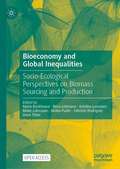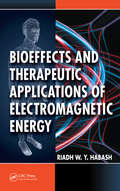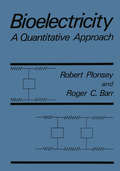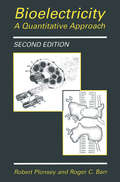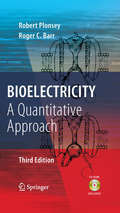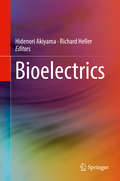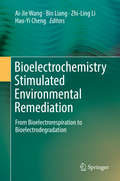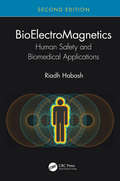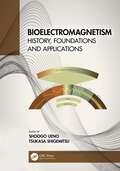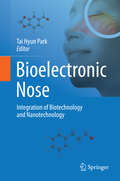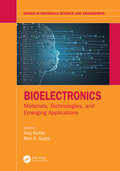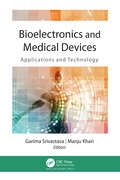- Table View
- List View
Biodynamics: Circulation
by Y. C. FungThis book is a continuation ofmy Biomechanics.The first volume deals with the mechanical properties of living tissues. The present volume deals with the mechanics ofcirculation. A third volume willdeal with respiration, fluid balance, locomotion, growth, and strength. This volume is called Bio dynamics in order to distinguish it from the first volume. The same style is followed. My objective is to present the mechanical aspects ofphysiology in precise terms ofmechanics so that the subject can become as lucid as physics. The motivation of writing this series of books is, as I have said in the preface to the first volume, to bring biomechanics to students ofbioengineer ing, physiology, medicine, and mechanics. I have long felt a need for a set of books that willinform the students ofthe physiological and medical applica tions ofbiomechanics,and at the same time develop their training in mechan ics. In writing these books I have assumed that the reader already has some basic training in mechanics, to a level about equivalent to the first seven chapters of my First Course in Continuum Mechanics (Prentice Hall, 1977). The subject is then presented from the point of view of life science while mechanics is developed through a sequence of problems and examples. The main text reads like physiology, while the exercises are planned like a mechanics textbook.The instructor may filla dual role :teaching an essential branch of life science, and gradually developing the student's knowledge in mechanics.
Bioeconomics of Fisheries Management
by Lee G. Anderson Juan Carlos SeijoFisheries Economics has always been an interdisciplinary field of study with economic analysis based on stock population dynamics, but many published works have focused mainly on theoretical economic issues without much focus on biological details. For the most part, age structured models have been ignored. Bioeconomics of Fisheries Management is a valuable reference text that presents the economic aspects of fisheries management in a broad bioeconomic framework. The book is broken into two parts. Part I covers the traditional areas of fisheries economics, covering topics such as open access, optimal and managed fisheries utilization that is analyzed through a traditional one stock/one fleet model. It also presents the basic results in terms of an age structured model. Part II covers material related to more recent work on bioeconomic models when more rigorous biological components became more prevalent, and views fisheries management with an ecosystems-based approach. Accompanying the book is a user-friendly CD with exercises and examples that aids the reader in applying theoretical principles of population dynamics and fisheries management and regulation. Bioeconomics of Fisheries Management will be a valuable text for researchers, fisheries economists, professionals, and students alike.
Bioeconomics of Fisheries Management
by Lee G. Anderson Juan Carlos SeijoFisheries Economics has always been an interdisciplinary field of study with economic analysis based on stock population dynamics, but many published works have focused mainly on theoretical economic issues without much focus on biological details. For the most part, age structured models have been ignored. Bioeconomics of Fisheries Management is a valuable reference text that presents the economic aspects of fisheries management in a broad bioeconomic framework. The book is broken into two parts. Part I covers the traditional areas of fisheries economics, covering topics such as open access, optimal and managed fisheries utilization that is analyzed through a traditional one stock/one fleet model. It also presents the basic results in terms of an age structured model. Part II covers material related to more recent work on bioeconomic models when more rigorous biological components became more prevalent, and views fisheries management with an ecosystems-based approach. Accompanying the book is a user-friendly CD with exercises and examples that aids the reader in applying theoretical principles of population dynamics and fisheries management and regulation. Bioeconomics of Fisheries Management will be a valuable text for researchers, fisheries economists, professionals, and students alike.
Bioeconomy and Global Inequalities: Socio-Ecological Perspectives on Biomass Sourcing and Production
by Maria Backhouse Rosa Lehmann Kristina Lorenzen Malte Lühmann Janina Puder Fabricio Rodríguez Anne TittorThis open access book focuses on the meanings, agendas, as well as the local and global implications of bioeconomy and bioenergy policies in and across South America, Asia and Europe. It explores how a transition away from a fossil and towards a bio-based economic order alters, reinforces and challenges socio-ecological inequalities. The volume presents a historically informed and empirically rich discussion of bioeconomy developments with a particular focus on bio-based energy. A series of conceptual discussions and case studies with a multidisciplinary background in the social sciences illuminate how the deployment of biomass sources from the agricultural and forestry sectors affect societal changes concerning knowledge production, land and labour relations, political participation and international trade. How can a global perspective on socio-ecological inequalities contribute to a complex and critical understanding of bioeconomy? Who participates in the negotiation of specific bioeconomy policies and who does not? Who determines the agenda? To what extent does the bioeconomy affect existing socio-ecological inequalities in rural areas? What are the implications of the bioeconomy for existing relations of extraction and inequalities across regions? The volume is an invitation to reflect upon these questions and more, at a time when the need for an ecological and socially just transition away from a carbon intensive economy is becoming increasingly pressing.
Bioeconomy for Beginners
by Stephan Meyer Wolfgang Zettlmeier Ulrich SchurrThis book provides an interdisciplinary and comprehensible introduction to bioeconomy. It thus provides basic knowledge for understanding a transformation process that will shape the 21st century and requires the integration of many disciplines and industries that have had little to do with each other up to now. We are talking about the gradual and necessary transition from the age of fossil fuels, which began around 200 years ago, to a global economy based on renewable raw materials (and renewable energies). The success of this transition is key to coping with the challenge of climate change. This book conceives the realization of bioeconomy as a threefold task – a scientific, an economic and an ecological one. · Where does the biomass come from that we need primarily for feeding the growing world population but also for future energy and material use? How can it be processed in biorefineries and what role does biotechnology play in this regard? · Which aspects of innovation economics need to be considered, which economic aspects of value creation, competitiveness and customer acceptance are important? · What conditions must a bioeconomy fulfil in order to enable a sustainable development of life on earth? May it be regarded as a key to further economic growth or shouldn’t it rather orient itself towards the ideal of sufficiency? By dealing with these questions from the not necessarily consistent perspectives of proven experts, this book provides an interdisciplinary overview of a dynamic field of research and practice that raises more questions than answers and thus may nurture the motivation of many more people to seriously engage for the realization of a bioeconomy.
Bioeconomy for Sustainability
by Vinod Kumar Garg Navish KatariaThis edited volume covers the key role of bioeconomy for next-generation industrial production to achieve Sustainable Development Goals. It addresses the key environmental challenges due to biowaste generation and their application in boosting the economy through the conversion of biowaste into valuable products for sustainable growth and future needs. This book also describes the potential future research scope and possibilities in bioeconomy towards sustainable industrial ecology and circular economy. In recent years, competition has increased for determinate resources. There is an urgent need to look for sustainable, non-polluting alternate sources to meet the demands of an ever-increasing population. Sustainable processes and production while using biological material can produce food, fodder, agricultural inputs, fuel etc. with lesser inputs and reduced emission of pollutants. Agricultural waste and food waste are another concern which demands immediate interventions. The Bioeconomy can be a possible way to address these challenges. It includes sustainable production of food, fodder, fiber, fuel, agricultural inputs, and other goods while using renewable resources or different types of waste. This is beneficial to resolve diverse environmental problems such as future bioenergy production technology, societal transformations, pollution management, industrial circular economy, agricultural practices and food securities, climate management etc. Bioeconomy helps to move from a linear economy to a circular economy. This book is a valuable source for researchers, teachers, and undergraduate and graduate students of environmental science, environmental economics, agriculture science, biotechnology, ecology, and soil science. It also serves as additional reading material for professionals, scientists, stakeholders of government and non-government organizations, industrialists, and policymakers of the relevant fields.
Bioeconomy for Sustainable Development
by Chetan KeswaniThe current era of incredible innovations has made science and technology one of the most powerful tools to meet the goals of incremental prosperity for humans and sustainable development. The development of the biotech industry in any given country is shaped by the characteristics of the technology—particularly its close relation to scientific knowledge—and by country-specific factors—the level and nature of the scientific knowledge base, the institutional set-up, and the role assumed by the government—which influence the country's ability to exploit new opportunities and appropriate the respective results.This book presents an integrated approach for sustained innovation in various areas of biotechnology. Focusing mainly on the industrial, socio-economic and legal implications of biotechnological advances, it examines in detail not only the implications of IPR in omics-based research but also the ethical and intellectual standards and how these can be developed for sustained innovation.Integrating science and business, it offers a peek behind the scenes of the biotech industry and provides a comprehensive analysis of the foundations of the present day industry for students and professionals alike. The book is divided into three parts: Food and Agricultural BiotechnologyIndustrial BiotechnologyPharmaceutical Biotechnology
Bioeffects and Therapeutic Applications of Electromagnetic Energy
by Riadh HabashFrom cell phones to treating cancer, EM energy plays a part in many of the innovations that we take for granted everyday. A basic force of nature, like nuclear energy or gravity, this energy can be harnessed and used, but still holds the potential to be harmful. The question remains, how safe are EM products? Bioeffects and Therapeutic Applicati
Bioelectricity: A Quantitative Approach
by Roger C. Barr Robert PlonseyThis text is an introduction to electrophysiology, following a quantitative approach. The first chapter summarizes much of the mathematics required in the following chapters. The second chapter presents a very concise overview of the general principles of electrical fields and current flow, mostly es tablished in physical science and engineering, but also applicable to biolog ical environments. The following five chapters are the core material of this text. They include descriptions of how voltages come to exist across membranes and how these are described using the Nernst and Goldman equations (Chapter 3), an examination of the time course of changes in membrane voltages that produce action potentials (Chapter 4), propagation of action potentials down fibers (Chapter 5), the response of fibers to artificial stimuli such as those used in pacemakers (Chapter 6), and the voltages and currents produced by these active processes in the surrounding extracellular space (Chapter 7). The subsequent chapters present more detailed material about the application of these principles to the study of cardiac and neural electrophysiology, and include a chapter on recent developments in mem brane biophysics. The study of electrophysiology has progressed rapidly because of the precise, delicate, and ingenious experimental studies of many investigators. The field has also made great strides by unifying the numerous experimental observations through the development of increasingly accurate theoretical concepts and mathematical descriptions. The application of these funda mental principles has in turn formed a basis for the solution of many different electrophysiological problems.
Bioelectricity: A Quantitative Approach
by Robert Plonsey Roger C. BarrIn the first edition of Bioelectricity, Plonsey and Barr provided an introduction to electrophysiology following a quantitative approach. In this second edition they address new discoveries in the field of ion channels. The text is an introduction to electrophysiology utilizing a quantitative approach. It describes the principles of electrical fields, using basic principles from science and engineering while taking the biological applications into consideration. The book thus provides an introduction to the quantitative description of underlying electrophysiology with illustrative application to cardiac electrophysiology and functional electrical stimulation. The book can be used as a bridge to more advanced texts, particularly those that stress a quantitative approach.
Bioelectricity: A Quantitative Approach
by Robert Plonsey Roger C. BarrThis is the new edition of the classic introductory text to electrophysiology. It covers many topics that are central to the field including the electrical properties of the cell membrane and cardiac electrophysiology. Organized as a textbook for the student needing to acquire the core competencies, this book meets the demands of advanced undergraduate or graduate coursework in biomedical engineering and biophysics. New features include extra, detailed illustrations. The book is authored by two eminent biomedical engineering professors at Duke University who discuss many topics that are central to biophysics and bioengineering and the quantitative methods employed.
Bioelectrics
by Hidenori Akiyama Richard HellerThis book focuses on bioelectrics, a new multidisciplinary field encompassing engineering and biology with applications to the medical, environmental, food, energy, and biotechnological fields. At present, 15 universities and institutes in Japan, the USA and the EU comprise the International Consortium of Bioelectrics, intended to advance this novel and important research field. This book will serve as an introductory resource for young scientists and also as a textbook for use by both undergraduate and graduate students – the world’s first such work solely devoted to bioelectrics.
Bioelectrochemical Systems: Vol.1 Principles and Processes
by Prasun Kumar Chandrasekhar KuppamThis book is the first in a two-volume set devoted to bioelectrochemical systems (BESs) and the opportunities that they may offer in providing a green solution to growing energy demands worldwide. In this first volume, established research professionals explain the underlying principles and processes of BESs, providing a thorough introduction to these systems before proceeding to address the roles of cathode catalysts and biocatalysts, biofilms, heterotrophic denitrification, and nanotechnology approaches. This volume forms a sound foundation for understanding the potential industrial applications of this technology, which include in particular the generation of high-value chemicals and energy using organic wastes. These applications are the focus of the second volume, where readers will find up-to-date information on microbial fuel cells and the use of microbial biofilm- and algae-based bioelectrochemical systems for bioremediation and co-generation of valuable chemicals. The book is designed for a broad audience, including undergraduates, postgraduates, energy researchers/scientists, policymakers, and anyone else interested in the latest developments in this field.
Bioelectrochemical Systems: Vol.2 Current and Emerging Applications
by Prasun Kumar Chandrasekhar KuppamThis book is the second in a two-volume set devoted to bioelectrochemical systems (BESs) and the opportunities that they may offer in providing a green solution to growing energy demands worldwide. While the first volume explains principles and processes, in this volume established research professionals shed light on how this technology can be used to generate high-value chemicals and energy using organic wastes. Bioelectricity is generated in microbial fuel cells (MFCs) under oxygen-depleted conditions, where microbial bioconversion reactions transform organic wastes into electrons. Dedicated chapters focus on MFCs and state of the art advancements as well as current limitations. In addition, the book covers the use of microbial biofilm- and algae-based bioelectrochemical systems for bioremediation and co-generation of valuable chemicals. A thorough review of the performance of this technology and its possible industrial applications is presented. The book is designed for a broad audience, including undergraduates, postgraduates, energy researchers/scientists, policymakers, and anyone else interested in the latest developments in this field.
Bioelectrochemistry Stimulated Environmental Remediation: From Bioelectrorespiration to Bioelectrodegradation
by Ai-Jie Wang Bin Liang Zhi-Ling Li Hao-Yi ChengThis book reviews the latest advances in the bioelectrochemical degradation of recalcitrant environmental contaminants. The first part introduces readers to the basic principles and methodologies of bioelectrochemical systems, electron-respiring microorganisms, the electron transfer mechanism and functional electrode materials. In turn, the second part addresses the bioelectrochemical remediation/treatment of various environmental pollutants (including highly toxic refractory organics, heavy metals, and nitrates) in wastewater, sediment and wetlands. Reactor configuration optimization, hybrid technology amplification and enhanced removal principles and techniques are also discussed.The book offers a valuable resource for all researchers and professionals working in environmental science and engineering, bioelectrochemistry, environmental microbiology and biotechnology.
BioElectroMagnetics: Human Safety and Biomedical Applications
by Riadh HabashThis book is an educational resource of evolving scientific knowledge in the area of bioelectromagnetics that may serve the interests of students and decision-makers, as well as society as a whole. It is distinguished by extensive descriptions of fundamental biophysical concepts and their relevance to human health. Reflecting the transdisciplinary approach from several different intellectual streams including physics, biology, epidemiology, medicine, environment, risk science, and engineering, the book is quite a venture into the battling studies to assess the latest research on health effects and biomedical applications of EM energy. This new edition of the book particularly looks at the potential threats from the emerging 5G wireless networks, which will deploy large numbers of low-powered smartphones, notebooks, tablets, radio access networks, and other transmitters. Features Introduces necessary biophysical principles of EM fields in the context of their interaction with living systems. Strengthens understanding of cutting-edge research on several major areas in the broad area of bioelectromagnetics. Presents safety standards and guidelines for human exposure to EM fields. Discusses techniques that have been developed to ensure adequate EM-thermal dosimetry required for both health effects and biomedical applications. Provides insight into the determinants of EM health risk assessment and public concerns. Includes extensive reference list at the end of each chapter to enhance further study. Riadh Habash is a special appointment professor and McLaughlin Research Chair in Electromagnetic Fields and Health at the University of Ottawa, Canada. He has been the recipient of many awards, including the National Wighton Fellowship Award, and has authored or co-authored over 90 research articles, six books, and five book chapters. His most recent books are Green Engineering in 2017 and Professional Practice in 2019 (CRC Press), with the remaining previous books targeting the area of bioelectromagnetics.
BioElectroMagnetics: Human Safety and Biomedical Applications
by Riadh HabashThis book is an educational resource of evolving scientific knowledge in the area of bioelectromagnetics that may serve the interests of students and decision-makers, as well as society as a whole. It is distinguished by extensive descriptions of fundamental biophysical concepts and their relevance to human health. Reflecting the transdisciplinary approach from several different intellectual streams including physics, biology, epidemiology, medicine, environment, risk science, and engineering, the book is quite a venture into the battling studies to assess the latest research on health effects and biomedical applications of EM energy. This new edition of the book particularly looks at the potential threats from the emerging 5G wireless networks, which will deploy large numbers of low-powered smartphones, notebooks, tablets, radio access networks, and other transmitters. Features Introduces necessary biophysical principles of EM fields in the context of their interaction with living systems. Strengthens understanding of cutting-edge research on several major areas in the broad area of bioelectromagnetics. Presents safety standards and guidelines for human exposure to EM fields. Discusses techniques that have been developed to ensure adequate EM-thermal dosimetry required for both health effects and biomedical applications. Provides insight into the determinants of EM health risk assessment and public concerns. Includes extensive reference list at the end of each chapter to enhance further study. Riadh Habash is a special appointment professor and McLaughlin Research Chair in Electromagnetic Fields and Health at the University of Ottawa, Canada. He has been the recipient of many awards, including the National Wighton Fellowship Award, and has authored or co-authored over 90 research articles, six books, and five book chapters. His most recent books are Green Engineering in 2017 and Professional Practice in 2019 (CRC Press), with the remaining previous books targeting the area of bioelectromagnetics.
Bioelectromagnetism: History, Foundations and Applications
by Shoogo UenoBioelectromagnetism has been gradually developing and expanding into a variety of fields in engineering, biomedical engineering, life science, medicine and biology. Bioelectromagnetism: History, Foundations and Applications provides an overview of the field and its developments; from its inception and growth through the twenty-first century, to the latest advances in electro- and magnetobiology and hazard evaluations of electromagnetic fields.It is organized into three sections, each focusing on specific regions of bioelectromagnetism. It begins with the foundations of the field and its history, with a chronological treatment of the major subjects in bioelectromagnetism. The relationship between atmospheric electromagnetic phenomena, geomagnetism and biological systems are presented. It then discusses the many benefits of bioelectromagnetism: electroreception, magnetic navigation, magnetic sense and magnetic responses of plants, birds, animals and humans. It then moves on to human health issues and the impact of bioelectromagnetism. It also provides practical guidance on how to set safety guidelines. Finally, it looks forward to the future prospects of the field based on the latest research in the field.In exploring both the history of the field and the latest developments in today’s research advances, this book provides a comprehensive and self-contained treatment on the subject, which will be a valuable reference for researchers in biophysics, medicine, electrical engineering and biomedical engineering.It can be used as a companion to the editor’s previously published books: Biomagnetics: Principles and Applications of Biomagnetic Stimulation and Imaging (9781482239201, 2016, CRC Press); and Bioimaging: Imaging by Light and Electromagnetics in Medicine and Biology (9780367203047, 2020, CRC Press).Key Features: Provides both a historical view of the field, along with the latest developments in the field Contains practical guidance for researchers on how to set safety guidelines for those working in the area Edited by authorities in the field, with chapter contributions from specialists
Bioelectromagnetism: History, Foundations and Applications
by Shoogo Ueno Tsukasa ShigemitsuBioelectromagnetism has been gradually developing and expanding into a variety of fields in engineering, biomedical engineering, life science, medicine and biology. Bioelectromagnetism: History, Foundations and Applications provides an overview of the field and its developments; from its inception and growth through the twenty-first century, to the latest advances in electro- and magnetobiology and hazard evaluations of electromagnetic fields.It is organized into three sections, each focusing on specific regions of bioelectromagnetism. It begins with the foundations of the field and its history, with a chronological treatment of the major subjects in bioelectromagnetism. The relationship between atmospheric electromagnetic phenomena, geomagnetism and biological systems are presented. It then discusses the many benefits of bioelectromagnetism: electroreception, magnetic navigation, magnetic sense and magnetic responses of plants, birds, animals and humans. It then moves on to human health issues and the impact of bioelectromagnetism. It also provides practical guidance on how to set safety guidelines. Finally, it looks forward to the future prospects of the field based on the latest research in the field.In exploring both the history of the field and the latest developments in today’s research advances, this book provides a comprehensive and self-contained treatment on the subject, which will be a valuable reference for researchers in biophysics, medicine, electrical engineering and biomedical engineering.It can be used as a companion to the editor’s previously published books: Biomagnetics: Principles and Applications of Biomagnetic Stimulation and Imaging (9781482239201, 2016, CRC Press); and Bioimaging: Imaging by Light and Electromagnetics in Medicine and Biology (9780367203047, 2020, CRC Press).Key Features: Provides both a historical view of the field, along with the latest developments in the field Contains practical guidance for researchers on how to set safety guidelines for those working in the area Edited by authorities in the field, with chapter contributions from specialists
Bioelectronic Nose: Integration of Biotechnology and Nanotechnology
by Tai Hyun ParkThe “bioelectronic nose”, the device which has a similar function to the human smell sensing system, can be realized by combining the olfactory cells or receptors with nanotechnology. In the last two decades, much has been learned about the smell sensing mechanism in biological systems. With knowledge about the biological olfactory system and the techniques for the expression of biological receptor proteins, we are able to utilize biological materials and systems to mimic the biological olfactory system. In addition to the advances in biological and biotechnological area, nanotechnology has progressed to a great degree. The bioelectronic nose is a good example of the integration of biotechnology and nanotechnology. This book describes basic biological sciences of the olfactory system, biotechnology for the production of olfactory biological elements, and nanotechnology for the development of various sensing devices. The purpose of this book is to provide the reader with a concept, basic sciences, fundamental technologies, applications, and perspectives of the bioelectronic nose.
Bioelectronics: Materials, Technologies, and Emerging Applications (Series in Materials Science and Engineering)
by Anuj Kumar Ram K. GuptaBioelectronics is emerging as a new area of research where electronics can selectively detect, record, and monitor physiological signals. This is a rapidly expanding area of medical research, that relies heavily on multidisciplinary technology development and cutting-edge research in chemical, biological, engineering, and physical science. This book provides extensive information on the (i) fundamental concepts of bioelectronics, (ii) materials for the developments of bioelectronics such as implantable electronics, self-powered devices, bioelectronic sensors, flexible bioelectronics, etc, and (iii) an overview of the trends and gathering of the latest bioelectronic progress. This book will broaden our knowledge about newer technologies and processes used in bioelectronics.
Bioelectronics: Materials, Technologies, and Emerging Applications (Series in Materials Science and Engineering)
by Anuj Kumar Ram K. GuptaBioelectronics is emerging as a new area of research where electronics can selectively detect, record, and monitor physiological signals. This is a rapidly expanding area of medical research, that relies heavily on multidisciplinary technology development and cutting-edge research in chemical, biological, engineering, and physical science. This book provides extensive information on the (i) fundamental concepts of bioelectronics, (ii) materials for the developments of bioelectronics such as implantable electronics, self-powered devices, bioelectronic sensors, flexible bioelectronics, etc, and (iii) an overview of the trends and gathering of the latest bioelectronic progress. This book will broaden our knowledge about newer technologies and processes used in bioelectronics.
Bioelectronics and Medical Devices: Applications and Technology
by Garima Srivastava, Manju KhariThis new volume provides an abundance of information on new biomedical applications being used today. The book covers a wide range of concepts and technologies, discussing such modern technological methods as the Internet of Things, e-pills, biomedical sensors, support vector machines, wireless devices, image and signal processing in e-health, and machine learning. It also includes a discussion on software implementation for the devices used in biomedical applications. The different types of antennas, including antennas using RF energy harvesting for biomedical applications, are covered as well.
Bioelectronics and Medical Devices: Applications and Technology
by Garima Srivastava Manju KhariThis new volume provides an abundance of information on new biomedical applications being used today. The book covers a wide range of concepts and technologies, discussing such modern technological methods as the Internet of Things, e-pills, biomedical sensors, support vector machines, wireless devices, image and signal processing in e-health, and machine learning. It also includes a discussion on software implementation for the devices used in biomedical applications. The different types of antennas, including antennas using RF energy harvesting for biomedical applications, are covered as well.
Bioelectrosynthesis: Principles and Technologies for Value-Added Products
by Aijie Wang Wenzong Liu Bo Zhang Weiwei CaiIntroduces basic principles and mechanisms, covers new developments, and provides a different view of the main facets of bioelectrosynthesis Bioelectrosynthesis represents a promising approach for storing renewable energy or producing target chemicals in an energy-sustainable and low-cost way. This timely and important book systemically introduces the hot issues surrounding bioelectrosynthesis, including potential value-added products via bioelectrochemical system, reactor development of bioelectrosynthesis, and microbial biology on biofilm communities and metabolism pathways. It presents readers with unique viewpoints on basic principles and mechanisms along with new developments on reactor and microbial ecology. Beginning with a principle and products overview of bioelectrosynthesis, Bioelectrosynthesis: Principles and Technologies for Value-Added Products goes on to offer in-depth sections on: biogas production and upgrading technology via bioelectrolysis; organic synthesis on cathodes; chemical products and nitrogen recovery; external electron transfer and electrode material promotion; and the microbiology of bioelectrosynthesis. Topics covered include: hydrogen production from waste stream with microbial electrolysis cell; microbial electrolysis cell; inorganic compound synthesis in bioelectrochemical system; microbial growth, ecological, and metabolic characteristics in bioelectrosynthesis systems; microbial metabolism kinetics and interactions in bioelectrosynthesis system; and more. * Comprehensively covers all of the key issues of biolelectrosynthesis * Features contributions from top experts in the field * Examines the conversion of organic wastes to methane via electromethanogenesis; methane production at biocathodes; extracellular electron transport of electroactive biofilm; and more Bioelectrosynthesis: Principles and Technologies for Value-Added Products will appeal to chemists, electrochemists, environmental chemists, water chemists, microbiologists, biochemists, and graduate students involved in the field.


